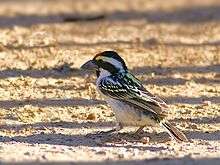Acacia pied barbet
The acacia pied barbet or pied barbet (Tricholaema leucomelas) is a species of bird in the family Lybiidae.
| Acacia pied barbet | |
|---|---|
.jpg) | |
| T. l. centralis Tswalu Kalahari Reserve], South Africa | |
| Scientific classification | |
| Kingdom: | Animalia |
| Phylum: | Chordata |
| Class: | Aves |
| Order: | Piciformes |
| Family: | Lybiidae |
| Genus: | Tricholaema |
| Species: | T. leucomelas |
| Binomial name | |
| Tricholaema leucomelas (Boddaert, 1783) | |
| Synonyms | |
| |
Taxonomy
The acacia pied barbet was described by the French polymath Georges-Louis Leclerc, Comte de Buffon in 1780 in his Histoire Naturelle des Oiseaux from a specimen collected from the Cape of Good Hope region of South Africa.[2] The bird was also illustrated in a hand-coloured plate engraved by François-Nicolas Martinet in the Planches Enluminées D'Histoire Naturelle which was produced under the supervision of Edme-Louis Daubenton to accompany Buffon's text.[3] Neither the plate caption nor Buffon's description included a scientific name but in 1783 the Dutch naturalist Pieter Boddaert coined the binomial name Bucco leucomelas in his catalogue of the Planches Enluminées.[4] The acacia pied barbet is now placed in the genus Tricholaema that was introduced by the French brothers Jules and Édouard Verreaux in 1855.[5][6] The generic name combines the Ancient Greek thrix meaning hair and laimos meaning "throat". The specific leucomelas combines the Ancient Greek leukos meaning "white" and melas meaning "black".[7]
Three subspecies are recognised:[6]
Description
The acacia pied barbet has a black-and-white striped head with a red forehead and yellow colouring above the eyes. It has a black bib under the chin, with a white breast and underparts.
Distribution and habitat
It primarily inhabits semi-arid savanna, as well as grassland, fynbos, agricultural areas and urban gardens, where it did not inhabit previously. With the introduction of alien vegetation, especially Acacia species from Australia, to regions bordering its original range, this species has been able to expand its range to these otherwise unreachable areas.[8]
It is found in Angola, Botswana, Lesotho, Mozambique, Namibia, South Africa, Swaziland, Zambia, and Zimbabwe.
Behaviour and ecology

Like most other barbets, the acacia pied barbet drills holes into dead wood to create cavity nests, like a woodpecker. It lays two to four eggs from August to April, and both sexes incubate the eggs.
The acacia pied barbet has been observed taking fruit from various trees and shrubs, such as Ficus, Rhus and Phoenix reclinata, as well as Aloe nectar and insects.
References
- BirdLife International (2012). "Tricholaema leucomelas". IUCN Red List of Threatened Species. 2012. Retrieved 26 November 2013.CS1 maint: ref=harv (link)
- Buffon, Georges-Louis Leclerc de (1780). "Le barbu a plastron noir". Histoire Naturelle des Oiseaux (in French). Volume 13. Paris: De L'Imprimerie Royale. pp. 155–156.
- Buffon, Georges-Louis Leclerc de; Martinet, François-Nicolas; Daubenton, Edme-Louis; Daubenton, Louis-Jean-Marie (1765–1783). "Barbu, du Cap de bonne-Esperance". Planches Enluminées D'Histoire Naturelle. Volume 7. Paris: De L'Imprimerie Royale. Plate 688 Fig. 1.
- Boddaert, Pieter (1783). Table des planches enluminéez d'histoire naturelle de M. D'Aubenton : avec les denominations de M.M. de Buffon, Brisson, Edwards, Linnaeus et Latham, precedé d'une notice des principaux ouvrages zoologiques enluminés (in French). Utrecht. p. 43, Number 688 Fig. 1.
- Verreaux, Jules; Verreaux, Édouard. "Oiseaux nouveaux du Gabon". Journal für Ornithologie (in Latin and French). 3: 101-106 [102–103].
- Gill, Frank; Donsker, David, eds. (2019). "Jacamars, puffbirds, toucans, barbets, honeyguides". World Bird List Version 9.2. International Ornithologists' Union. Retrieved 6 August 2019.
- Jobling, James A. (2010). The Helm Dictionary of Scientific Bird Names. London: Christopher Helm. pp. 224, 389. ISBN 978-1-4081-2501-4.
- "Archived copy". Archived from the original on 2012-01-01. Retrieved 2012-01-13.CS1 maint: archived copy as title (link)
External links
- (Acacia) pied barbet - Species text in The Atlas of Southern African Birds
